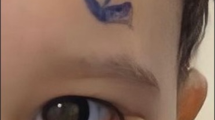Abstract
Choristomas are congenital lesions presenting normal tissue in an abnormal location. A conjunctival dermolipoma is a congenital choristomas tumor usually localized in the temporal aspects of the bulbar conjunctiva, near the lateral canthus. It may be associated with developmental anomalies of the second branchial arch, such as Goldenhar syndrome. The association between dermolipoma and lateral canthal cleft without other congenital anomalies is uncommon. The purpose of this paper is to present a series of isolated choristomas in the lateral canthus associated with a lateral cleft. We present 3 cases of dermolipoma at the lateral canthus associated with isolated lateral cleft. The dermolipomas’ appearance ranges from a flat lesion to a large pedunculated tumor, obliterating the lateral conjunctival fornix. A partial removal of the dermolipoma was done with canthoplasty to close the lateral coloboma. Surgical management of dermolipoma with partial excision aimed at reducing visible tumor produced good cosmetic results, without complications. Microscopic examination of the tumor revealed a mass covered by stratified squamous keratinized epithelium. The mass comprised largely of mature adipose tissue interspersed with bundles of collagen. The presence of pilosebaceous units was also noted. Based on these features, a histopathological diagnosis of a dermolipoma was made. The association between dermolipoma and isolated lateral canthal cleft is much less common than the associations with other distinguishing abnormalities. In summary, these cases illustrate that dermolipomas are also a part of a wide spectrum that characterizes benign growths of the eyelids.
Level of evidence: Level V, therapeutic study.



Similar content being viewed by others
References
Spencer WH (1985) Ophthalmic pathology. In: An atlas and textbook, 3rd edn. WB Saunders, Philadelphia, pp 121–128
Mansur A, Barber JC, Reinecke RD, Wang FM (1989) Ocular choristomas. Surv Ophthalmol 33:339–358
Beard C (1990) Dermatolipma surgery, or “an ounce of prevention is worth pound of cure”. Ophthal Plast Reconstr Surg 6:153–157
Shields CL, Shields JA (2007) Conjunctival tumors in children. Curr Opin Ophthalmol 18:351–360
Eijepe AA, Koorneef L, Bras J et al (1990) Dermolipoma: characteristic CT appearance. Doc Ophthalmol 74:321–328
Baum JL, Feingold M (1973) Ocular aspects of Goldenhar’s syndrome. Am J Ophthalmol 75:250–257
Elsas FJ, Green WR (1973) Epibulbar tumors in childhood. Am J Ophthalmol 79:1001–1007
Gayre GS, Proia AD, Duton JJ (2002) Epibulbar osseous choristoma: case report and review of the ltersture. Ophtalmic Surg Lasers 33:410–415
Glover AT, Grove AS (1987) Subconjunctival orbital fat prolapse. Ophthal Plast Reconstr Surg 3:83–86
Jordan DR, Tse DT (1987) Herniated orbital fat. Can J Ophthalmol 22:173–177
Mc Nab AA (1999) Subconjunctival fat prolapse. Aust N Z Ophthalmol 27:33–36
Paris GL, Beard C (1973) Blepharoptosis following dermatolipoma surgery. Ann Ophthalmol 5:697–699
Fry CL, Leone CR Jr (1994) Safe management of dermlipomas. Arch Ophthalmol 112:1114–1116
Tessier P (1976) Anatomical classification of facial, craniofacial and lateral facial clefts. J Maxillofac Surg 4:69–72
Miller MT, Deutsh TA, Cronin C et al (1987) Amniotic band as a cause of ocular abdomalies. Am J Ophthalmol 104:270–279
MacDonald D, Schneider K, Della Rocca RC (1989) Childhood disorders of the orbit and ocular adnexa. In: Smith BC, Della Rocca RC, Nesi FA, Lisman RD (eds) Ophthalmic plastic and reconstructive, vol I. CV Mosby, St Louis, pp 327–341
Ganesh A, Rangaswami M (1999) Pedunculed dermolipoma with overlying upper lid coloboma and absolut lateral canthus: cause and effect? Eye 13:687–689
Author information
Authors and Affiliations
Corresponding author
Ethics declarations
Conflict of interest
S. Lessa, J. Pontello, D. Duarte, W. Costa, and P. Persichetti declared no potential conflicts of interest with respect to the research, authorship, and publication of this article.
Ethical approval
The Ethics Committee of the University of the State of Rio De Janeiro approved this study.
Disclosures and Source of Funding
The authors have no disclosures and no financial support was received for this study.
Patient consent
The patient provided written informed consent for the publication and the use of their images.
Funding
None.
Additional information
Publisher’s note
Springer Nature remains neutral with regard to jurisdictional claims in published maps and institutional affiliations.
Rights and permissions
About this article
Cite this article
Lessa, S., Pontello, J., Duarte, D. et al. Lateral canthal choristomas associated with colobomas of lateral canthus. Eur J Plast Surg 44, 269–274 (2021). https://doi.org/10.1007/s00238-020-01701-4
Received:
Accepted:
Published:
Issue Date:
DOI: https://doi.org/10.1007/s00238-020-01701-4




